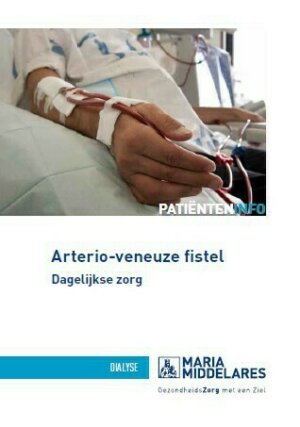Arteriovenous fistula
What is it?
What is it?An arteriovenous fistula or AV fistula is a subcutaneous connection between an artery and a vein, that can be created with a minor surgical intervention.
After it has been placed, an AV fistula cannot be used straight away. It has to mature first (= develop) as it were. The blood vessel should widen and have a solid wall. It is generally possible to use the AV fistula after four to six weeks.
If your own veins are not suitable for creating an AV fistula, the surgeon may decide to use an artificial blood vessel. This is a specially designed blood vessel that connects to an artery and vein. This creates a connection between these two blood vessels. With surgery, the artificial blood vessel is inserted into the forearm. The artificial blood vessel is often looped, but it can be straight too.
Course of the procedure
Course of the procedurePreparation for the procedure
During the consultation with the vascular surgeon, it is determined in which arm the AV fistula can be placed. The choice depends on:
- the condition of the blood vessels in your arm
- whether you are right-handed or left-handed.
- If your own blood vessels are not suitable for making an AV fistula, an artificial blood vessel (see above) may be a good choice. An AV fistula is placed in the wrist or, if that is not possible, in the lower arm or elbow. This connection is made surgically under a light general anaesthetic or, if possible, under a local anaesthetic.
During the consultation, the date of the operation is set. You will usually be admitted for one night. If you take blood-thinning medication, your physician will inform you how to adjust the dose of this medication.
The procedure itself
The procedure is performed under a light general anaesthetic or, if possible, under a local anaesthetic. After the operation, you will remain in the recovery room for a short while.
After the procedure
After the procedure, you will have a wound on your arm. The wound edges are held together with sutures. This allows them to grow back together properly.
Sometimes, a wound drain is fitted. This is a kind of tube through which blood and wound exudate can be drained.
The first days after the operation, the hand and lower arm may be swollen. When you are in bed, you can raise your lower arm slightly by placing it on a pillow.
The sutures are removed after approximately ten days.
You must keep the wound dry in this period.
During any consultation with the nephrologist (kidney specialist) or when you are on dialysis, your fistula arm will be looked at externally. It also checks whether there is sufficient blood flow in your AV fistula. When the AV fistula has matured sufficiently (± after 6 weeks) and there is no sign of infection, injury or skin rash occur, the AV fistula can be needled for the first time.
Leaflet
LeafletMore information about the arteriovenous fistula, needling the fistula and possible complications can be found in the leaflet below.
Only available in Dutch:

Arterio-veneuze fistel
DownloadCentres and specialist areas
Centres and specialist areas
Latest publication date: 16/05/2024
Supervising author: Dr De Vleeschouwer Mieke



